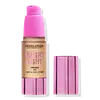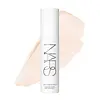What's inside
What's inside
 Key Ingredients
Key Ingredients

 Benefits
Benefits

 Concerns
Concerns

 Ingredients Side-by-side
Ingredients Side-by-side

Water
Skin ConditioningGlycerin
HumectantEthylhexyl Palmitate
EmollientButylene Glycol
HumectantMica
Cosmetic ColorantPolysorbate 60
EmulsifyingPolyacrylamide
Caprylic/Capric Triglyceride
MaskingPhenoxyethanol
PreservativeC13-14 Isoparaffin
EmollientCaprylyl Glycol
EmollientDisodium EDTA
Panthenol
Skin ConditioningEthylhexylglycerin
Skin ConditioningTocopheryl Acetate
AntioxidantParfum
MaskingAloe Barbadensis Leaf Juice
Skin ConditioningC9-11 Pareth-6
EmulsifyingSynthetic Fluorphlogopite
Tin Oxide
AbrasiveTocopherol
AntioxidantCitric Acid
BufferingSodium Benzoate
MaskingPotassium Sorbate
PreservativeSodium Sulfite
PreservativeCinnamyl Alcohol
PerfumingCI 77891
Cosmetic ColorantCI 77491
Cosmetic ColorantCI 77499
Cosmetic ColorantCI 77492
Cosmetic ColorantWater, Glycerin, Ethylhexyl Palmitate, Butylene Glycol, Mica, Polysorbate 60, Polyacrylamide, Caprylic/Capric Triglyceride, Phenoxyethanol, C13-14 Isoparaffin, Caprylyl Glycol, Disodium EDTA, Panthenol, Ethylhexylglycerin, Tocopheryl Acetate, Parfum, Aloe Barbadensis Leaf Juice, C9-11 Pareth-6, Synthetic Fluorphlogopite, Tin Oxide, Tocopherol, Citric Acid, Sodium Benzoate, Potassium Sorbate, Sodium Sulfite, Cinnamyl Alcohol, CI 77891, CI 77491, CI 77499, CI 77492
Water
Skin ConditioningPropanediol
SolventGlycerin
HumectantSqualane
EmollientIsodecyl Neopentanoate
EmollientC9-12 Alkane
SolventPolyurethane-35
Mica
Cosmetic ColorantTrehalose
HumectantChondrus Crispus Extract
Skin ConditioningCamellia Japonica Flower Extract
EmollientTheobroma Cacao Seed Extract
AntioxidantMoringa Oleifera Seed Extract
Skin ConditioningSodium Hyaluronate
HumectantGluconolactone
Skin ConditioningMethylpropanediol
SolventCaprylyl Glycol
EmollientPhenylpropanol
MaskingHydrogenated Lecithin
EmulsifyingCoco-Caprylate/Caprate
EmollientSodium Carrageenan
Emulsion StabilisingSea Salt
AbrasivePhytosteryl/Octyldodecyl Lauroyl Glutamate
Skin ConditioningTocopherol
AntioxidantMangifera Indica Seed Butter
Skin ConditioningOrbignya Oleifera Seed Oil
EmollientPhospholipids
Skin ConditioningTocopheryl Acetate
AntioxidantHydroxyethyl Acrylate/Sodium Acryloyldimethyl Taurate Copolymer
Emulsion StabilisingPolysorbate 60
EmulsifyingSorbitan Isostearate
EmulsifyingAmmonium Acryloyldimethyltaurate/Vp Copolymer
Sodium PCA
HumectantSodium Acrylates Crosspolymer-2
AbsorbentHydrolyzed Hyaluronic Acid
HumectantXanthan Gum
EmulsifyingLecithin
EmollientSclerotium Gum
Emulsion StabilisingPullulan
Silica
AbrasiveSynthetic Fluorphlogopite
Trisodium EDTA
Sodium Citrate
BufferingCitric Acid
BufferingButylene Glycol
HumectantPentylene Glycol
Skin ConditioningDisodium Phosphate
BufferingPhenoxyethanol
PreservativeSodium Benzoate
MaskingBenzyl Alcohol
PerfumingCI 77491
Cosmetic ColorantCI 14700
Cosmetic ColorantCI 77891
Cosmetic ColorantCI 19140
Cosmetic ColorantWater, Propanediol, Glycerin, Squalane, Isodecyl Neopentanoate, C9-12 Alkane, Polyurethane-35, Mica, Trehalose, Chondrus Crispus Extract, Camellia Japonica Flower Extract, Theobroma Cacao Seed Extract, Moringa Oleifera Seed Extract, Sodium Hyaluronate, Gluconolactone, Methylpropanediol, Caprylyl Glycol, Phenylpropanol, Hydrogenated Lecithin, Coco-Caprylate/Caprate, Sodium Carrageenan, Sea Salt, Phytosteryl/Octyldodecyl Lauroyl Glutamate, Tocopherol, Mangifera Indica Seed Butter, Orbignya Oleifera Seed Oil, Phospholipids, Tocopheryl Acetate, Hydroxyethyl Acrylate/Sodium Acryloyldimethyl Taurate Copolymer, Polysorbate 60, Sorbitan Isostearate, Ammonium Acryloyldimethyltaurate/Vp Copolymer, Sodium PCA, Sodium Acrylates Crosspolymer-2, Hydrolyzed Hyaluronic Acid, Xanthan Gum, Lecithin, Sclerotium Gum, Pullulan, Silica, Synthetic Fluorphlogopite, Trisodium EDTA, Sodium Citrate, Citric Acid, Butylene Glycol, Pentylene Glycol, Disodium Phosphate, Phenoxyethanol, Sodium Benzoate, Benzyl Alcohol, CI 77491, CI 14700, CI 77891, CI 19140
Ingredients Explained
These ingredients are found in both products.
Ingredients higher up in an ingredient list are typically present in a larger amount.
Butylene Glycol (or BG) is used within cosmetic products for a few different reasons:
Overall, Butylene Glycol is a safe and well-rounded ingredient that works well with other ingredients.
Though this ingredient works well with most skin types, some people with sensitive skin may experience a reaction such as allergic rashes, closed comedones, or itchiness.
Learn more about Butylene GlycolCaprylyl Glycol is a humectant and emollient, meaning it attracts and preserves moisture.
It is a common ingredient in many products, especially those designed to hydrate skin. The primary benefits are retaining moisture, skin softening, and promoting a healthy skin barrier.
Though Caprylyl Glycol is an alcohol derived from fatty acids, it is not the kind that can dry out skin.
This ingredient is also used as a preservative to extend the life of products. It has slight antimicrobial properties.
Learn more about Caprylyl GlycolCi 77491 is also hydrated iron III oxide. It's sole purpose is to give a red/pink hue to products.
Iron III oxides are classified as inorganic chemicals for coloring.
Synthetically created Ci 77491 is considered safer than those naturally found. This is because the synthetically created version may contain less impurities. Iron oxides are generally non-toxic and non-allergenic.
Learn more about CI 77491Ci 77891 is a white pigment from Titanium dioxide. It is naturally found in minerals such as rutile and ilmenite.
It's main function is to add a white color to cosmetics. It can also be mixed with other colors to create different shades.
Ci 77891 is commonly found in sunscreens due to its ability to block UV rays.
Learn more about CI 77891Citric Acid is an alpha hydroxy acid (AHA) naturally found in citrus fruits like oranges, lemons, and limes.
Like other AHAs, citric acid can exfoliate skin by breaking down the bonds that hold dead skin cells together. This helps reveal smoother and brighter skin underneath.
However, this exfoliating effect only happens at high concentrations (20%) which can be hard to find in cosmetic products.
Due to this, citric acid is usually included in small amounts as a pH adjuster. This helps keep products slightly more acidic and compatible with skin's natural pH.
In skincare formulas, citric acid can:
While it can provide some skin benefits, research shows lactic acid and glycolic acid are generally more effective and less irritating exfoliants.
Most citric acid used in skincare today is made by fermenting sugars (usually from molasses). This synthetic version is identical to the natural citrus form but easier to stabilize and use in formulations.
Read more about some other popular AHA's here:
Learn more about Citric AcidGlycerin is already naturally found in your skin. It helps moisturize and protect your skin.
A study from 2016 found glycerin to be more effective as a humectant than AHAs and hyaluronic acid.
As a humectant, it helps the skin stay hydrated by pulling moisture to your skin. The low molecular weight of glycerin allows it to pull moisture into the deeper layers of your skin.
Hydrated skin improves your skin barrier; Your skin barrier helps protect against irritants and bacteria.
Glycerin has also been found to have antimicrobial and antiviral properties. Due to these properties, glycerin is often used in wound and burn treatments.
In cosmetics, glycerin is usually derived from plants such as soybean or palm. However, it can also be sourced from animals, such as tallow or animal fat.
This ingredient is organic, colorless, odorless, and non-toxic.
Glycerin is the name for this ingredient in American English. British English uses Glycerol/Glycerine.
Learn more about GlycerinMica is a naturally occurring mineral used to add shimmer and color in cosmetics. It can also help improve the texture of a product or give it an opaque, white/silver color.
Serecite is the name for very fine but ragged grains of mica.
This ingredient is often coated with metal oxides like titanium dioxide. Trace amounts of heavy metals may be found in mica, but these metals are not harmful in our personal products.
Mica has been used since prehistoric times throughout the world. Ancient Egyptian, Indian, Greek, Roman, Aztec, and Chinese civilizations have used mica.
Learn more about MicaPhenoxyethanol is a preservative that has germicide, antimicrobial, and aromatic properties. Studies show that phenoxyethanol can prevent microbial growth. By itself, it has a scent that is similar to that of a rose.
It's often used in formulations along with Caprylyl Glycol to preserve the shelf life of products.
Polysorbate 60 is used to help stabilize products. It is a surfactant and emulsifier. These properties help keep ingredients together in a product. Surfactants help reduce surface tension between ingredients with different states, such as liquids and solids. Emulsifiers help prevent oils and waters from separating.
Polysorbate 60 is sorbitol-based and created from the ethoxylation of sorbitan. Ethoxylation is a chemical reaction used to add ethylene oxide. Sorbitan is a the dehydrated version of sorbitol, a sugar found in fruits.
In this case, the 60 comes from reacting 60 units of ethylene oxide with sorbitan.
Polysorbates are commonly used in medicine and foods.
Learn more about Polysorbate 60Sodium Benzoate is a preservative. It's used in both cosmetic and food products to inhibit the growth of mold and bacteria. It is typically produced synthetically.
Both the US FDA and EU Health Committee have approved the use of sodium benzoate. In the US, levels of 0.1% (of the total product) are allowed.
Sodium benzoate works as a preservative by inhibiting the growth of bacteria inside of cells. It prevents the cell from fermenting a type of sugar using an enzyme called phosphofructokinase.
It is the salt of benzoic acid. Foods containing sodium benzoate include soda, salad dressings, condiments, fruit juices, wines, and snack foods.
Studies for using ascorbic acid and sodium benzoate in cosmetics are lacking, especially in skincare routines with multiple steps.
We always recommend speaking with a professional, such as a dermatologist, if you have any concerns.
Learn more about Sodium BenzoateSynthetic Fluorphlogopite is the synthethic version of mica. It consists of fluorine, aluminum and silicate.
Synthetic Fluorphlogopite is used to add volume to products.
It is considered non-irritating on the skin.
Learn more about Synthetic FluorphlogopiteTocopherol (also known as Vitamin E) is a common antioxidant used to help protect the skin from free-radicals and strengthen the skin barrier. It's also fat soluble - this means our skin is great at absorbing it.
Vitamin E also helps keep your natural skin lipids healthy. Your lipid skin barrier naturally consists of lipids, ceramides, and fatty acids. Vitamin E offers extra protection for your skin’s lipid barrier, keeping your skin healthy and nourished.
Another benefit is a bit of UV protection. Vitamin E helps reduce the damage caused by UVB rays. (It should not replace your sunscreen). Combining it with Vitamin C can decrease sunburned cells and hyperpigmentation after UV exposure.
You might have noticed Vitamin E + C often paired together. This is because it is great at stabilizing Vitamin C. Using the two together helps increase the effectiveness of both ingredients.
There are often claims that Vitamin E can reduce/prevent scarring, but these claims haven't been confirmed by scientific research.
Learn more about TocopherolTocopheryl Acetate is AKA Vitamin E. It is an antioxidant and protects your skin from free radicals. Free radicals damage the skin by breaking down collagen.
One study found using Tocopheryl Acetate with Vitamin C decreased the number of sunburned cells.
Tocopheryl Acetate is commonly found in both skincare and dietary supplements.
Learn more about Tocopheryl AcetateWater. It's the most common cosmetic ingredient of all. You'll usually see it at the top of ingredient lists, meaning that it makes up the largest part of the product.
So why is it so popular? Water most often acts as a solvent - this means that it helps dissolve other ingredients into the formulation.
You'll also recognize water as that liquid we all need to stay alive. If you see this, drink a glass of water. Stay hydrated!
Learn more about Water